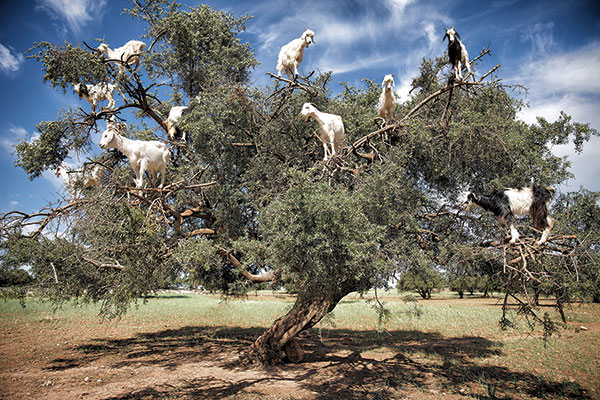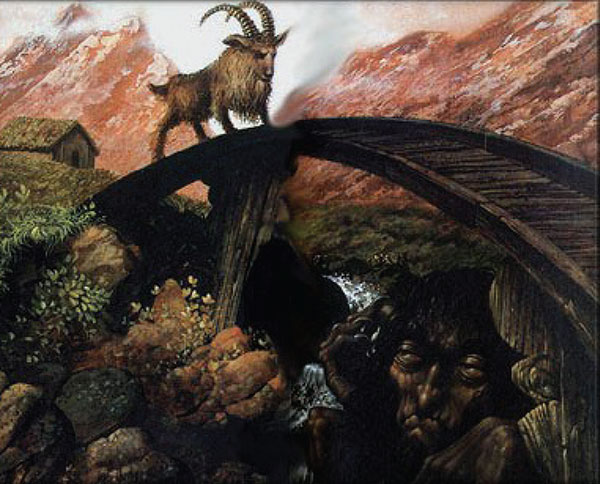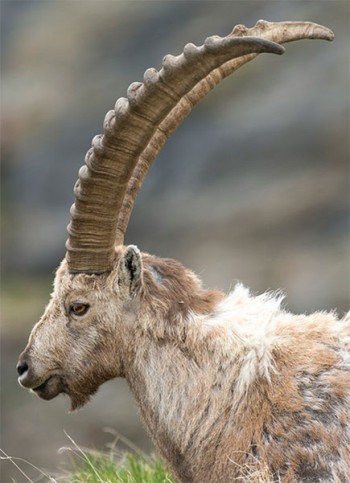Donna Carey, LAc and Ellen F. Franklin, PhD
Oriental Medicine Journal, New Year 2015
The Year of the Wood Goat begins on February 19, 2015. An exploration of the qualities of the goat and its appearance in cross cultural myths and fairy tales provides keys for the deep transformation that is possible in a goat year.
The Goat in Fairy Tale and Myth
 China
China
In China there is a goat god known as Yang Ching. He is depicted with a goat’s head and is dressed in goatskins. People appealed to Yang Ching for protection against wild animals.
In China, the goat spirit, Yang Ching, protected people from “wild” animals, and is the god of the “she” star, Fan-Yin. Yang Ching is the transcendent goat often described as having a white face, horns, a long beard, and a special ceremonial headdress. In Chinese as well as Mongolian cultures, the goat is quintessentially tied to the yang and representative of the masculine principal, practical, purposeful, accomplishing, persevering. Yet, there are also aspects of the goat that speak to the yin, in which the goat is identified as shy, timid, introverted, and sacrificing, providing mother’s milk that is rich in nutrients. Commentary on Hexagram 34 of the I Ching also provides examples of the dualistic nature of the goat; when resistance stops, the hedge opens, and the goat is able to move freely without being entangled.
Hexagram 34, Ta Chuang/Great Strength or Power
Meaning: To achieve true power and true greatness one must be in harmony with what is right. Great strength in this context is understood as a positive advance for further achievement. The structure of the gua is Thunder Above and Heaven Below. In mythology, storm gods such as Thor, Marduk, and Zeus also have a strong relationship to the Goat.
The I Ching, The Book of Changes, has many translations and rich interpretations. However, one thing that the translations share in common is that Hexagram 34, Ta Chuang, always references great strength and power, and refers to the persistence of the goat. Persistence will result in rewards and harvests. It is also linked to inner worth, a movement that is in harmony with the movement of heaven. True greatness is dependent on being in harmony with what is right. When we let go of resistance, the gates of success begin to open so that it is possible to forge ahead.
The goat is also noted for hardness on the outside and weakness within. Yet, when one is able to let go of obstinacy, all will flow. One example provided is that a goat will often butt its head against the hedge, unable to go backward, and yet it cannot go forward. If one notes this difficulty and lets go, good fortune will follow. Prefaced by san, or three, this is the image of three goats.
 The goat is generally described as being yang, yet there is an element of yin contained here as well. This is also represented in aspects of the Three Treasures – Heaven, Earth, and Humanity.
The goat is generally described as being yang, yet there is an element of yin contained here as well. This is also represented in aspects of the Three Treasures – Heaven, Earth, and Humanity.
The goat is generally associated with yang energy, particularly during a Wood year, when the goat may be full of itself and extremely active. However, the goat also has many yin qualities. It may be timid, taken to inward rumination or self-reflection and not acting on impulse. During this time of rapid Earth changes, the goat may be deeply reflective about what is unfolding on the planet. There is a strong association
between the goat god Yang Ching and the star Yin Feng, so we can think of the yang once again resting on the nurturance and sustenance of yin.
The goat is also associated with perfect balance, able to scale cliff sides and tall mountains. Of equal importance, we see in the goat’s ability to find balance even in the most precarious circumstances another manifestation of yang and yin and a strong link to the Three Treasures as represented in Heaven, Earth, and Humanity, or Shen, Jing, and Qi. The number three is frequently found in cross-cultural stories, fairy tales, and myths about the goat. The yang aspect is seen in Shen, Heaven, as the climber and achiever is motivated to ascend, reach, see, and rise up. Yin is seen in the Earthly aspect, relating to Jing, essence and sensuality. It is the goat as provider, of milk, meat, and fibers, that sets one hoof in front of the other to get whatever job is required done in a timely fashion. Goats living in community or herds are representative of Qi, humanity, home, and domestic life. They are curious and adventurous, expressing deep love for the Earth as well as the heavens in their lack of fear of the steep climb or the challenge of the journey, and by being infused with movement.
As we enter the Year of the Goat, there is no shortage of rich imagery and symbols, often charged with contradictions and psycho-spiritual ambiguity. Goats are powerful symbols for beauty, speed, elasticity, dignity, elegance of manner, and bearing. The goat has helped humanity throughout the ages, dating back to Neolithic times, around 12 million years ago. Records of their domestication can be traced back more that 10,000 years to the area known as the Fertile Crescent, a region of what today is known as the Middle East. Since these early times goats have adapted to domesticated life, but they also appear to easily adapt to life in the wild after being domesticated. Goats provide milk, cheese, meat, and dung for fuel, and the hair of the goat is used in fibers like cashmere and angora. Their hides are used to make botas (bottles) for water and wine transportation and parchment for writing. Beautiful paintings, drawings, and photographs of goats are a reminder of all that they have provided to humankind through their innate ability to guard, adapt, and face challenges with courage and dignity.
A goat is not a sheep is not a ram is not an antelope is not an ibex. Each of these animals has traits that are quite different from the goat.
Goats LOVE the earth so much that it is said that they run from rain so they can maintain the taste of dust and dirt. One of the great lessons we can learn from goats is to love the Earth, to reignite our passion for the riches, smells, and tastes of the Earth, and to recognize the critical importance of living in right relationship with our planet and all its beings.
As the 8th sign of the Chinese Zodiac, goats have a strong connection to prosperity, yang, daytime, fire, and good luck. Goats are ruminants with four-chambered stomachs. People often assume that goats will eat anything and everything, but this is incorrect. They are actually quite finicky and more discerning eaters than most urban dwelling humans. Because they are intelligent and inquisitive by nature, they will explore with tongues, chins, and lips anything in their environments. They are easily set apart from other animals — their hair is thin and coarse, their tails are short and pointed, their horns are straight, and they have beards, more sparse in females, which hold the breeding scent emanating from glands in the neck. The goat’s gestation period is five months. Kids are born with their eyes open; they stand up soon after birth; and they run and play in just a few days. Their mothers’ thick milk contains massive amounts of antibodies for their immune systems. Goats’ eyes have horizontal-slit pupils that contrast with the irises, providing an adaptation so that goats have a 320 degree view with no blind spots.
 Goats are survival oriented and weather resistant, agile climbers, sure-footed, adventurous, and very independent. They will launch into new territory at will, often climbing or tearing down fences. If they perceive a weakness in their pen, they will surely exploit it. Goats can hold their balance in precarious situations, and they are the only ruminants that can actually climb trees! They are hardy but not invincible. Goats love to communicate. They bleat, gurgle, stomp their legs, and cry out, as well as ram their horns, stick out their tongues, mock, glare, gaze, wag their tails, and charge. These amazing animals might well be the most fascinating, wonderful, misunderstood, and under-appreciated creatures in history.
Goats are survival oriented and weather resistant, agile climbers, sure-footed, adventurous, and very independent. They will launch into new territory at will, often climbing or tearing down fences. If they perceive a weakness in their pen, they will surely exploit it. Goats can hold their balance in precarious situations, and they are the only ruminants that can actually climb trees! They are hardy but not invincible. Goats love to communicate. They bleat, gurgle, stomp their legs, and cry out, as well as ram their horns, stick out their tongues, mock, glare, gaze, wag their tails, and charge. These amazing animals might well be the most fascinating, wonderful, misunderstood, and under-appreciated creatures in history.
It is from the goat that we get words such as “scapegoat,” which refers to someone who is unfairly blamed for something. This may well date back to the Old Testament religious practice on the Day of Atonement, when the sins of the people were transferred to a goat, the “scapegoat,” which was then taken into the wilderness and released, providing everyone with a fresh start in the New Year. To “get one’s goat” means to irritate or annoy someone, and to “play the goat” is to act the clown or behave in a silly fashion to make people laugh.
Western Zodiac
Capricorn is the 10th astrological sign of the Zodiac, ruled by Saturn, represented by the symbol of the goat and associated with the element of Earth. This sign is also associated with Vesta, the keeper of the hearth-fire and the fire within. Through Saturn and Vesta there are elements of spiritual rebirth and a powerful sense of purpose. Both of these Olympian deities represent self-mastery, which may be inner and spiritually directed, or present as an outward manifestation such as reaching the top of the mountain and obtaining mastery over others, stepping into one’s role as a leader. In the Northern Hemisphere, Capricorn occurs during the Winter Solstice, a major turning point when we move from darkness toward the light. At this time there is a great opportunity for individual consciousness to tap into the collective wellspring and begin a symbolic transformation represented through the return to the light. The mountain goat teaches us about discipline and reaching heights not just for ourselves but for the collective, and gives us vision, perseverance, and strength.
There are many mythological hybrids constructed from varying parts of the goat, including the Chimera. This fire breather is associated with initiation, and in medieval times it was associated with lust. The Chimera is also the offspring of the storm deity, depicted with three heads – the lion, goat, and snake. In addition, fauns and satyrs are most commonly depicted as part goat, part human.
But it is perhaps Ea, an early creator god of Sumer, depicted as a goat-fish, who influenced the imagery for the sign of Capricorn. Ea ruled the waters that kept the Tigris and Euphrates Rivers flowing underneath the Earth, supplying life to the land. He also provided wisdom to the people. In early Mesopotamian art, there are many images of goats feeding on the leaves of the Tree of Life.
Marduk, the son of Ea, is featured in the Babylonian Epic of Creation, the “Enuma Elis,” in which he battles the goddess Tiamet and creates the world from her body. Also identified as the patron god of the city of Babylon, a storm god, and a god of vegetation, he had the capacity both to help and to destroy humanity. Goats often accompanied Marduk, serving as adaptable and intelligent companions to the god.
 Norway
Norway
"The Three Billy Goats Gruff,” a Norwegian fairy tale, provides insights into the cleverness and perseverance of goats. This tale introduces us to a goat family that no longer has food to eat on their side of the river. In order to reach a rich meadow where grass is plentiful, they must get to the other side of the river. Unfortunately, this requires them to cross a bridge controlled by a nasty and fearsome troll. The three goats strategize a way to get across the bridge. The first goat to cross is the smallest. The troll jumps out, threatening to gobble up the goat. In a meek voice the littlest goat convinces the troll to wait for a heartier meal when his plump bigger brother comes across. The troll is convinced that the first goat is simply not worthy of his appetite, and thus the littlest goat is allowed to pass. A short time later the medium-sized billy goat cautiously approaches the bridge. As he begins to cross, the troll jumps out once again, ready to gobble up the goat. With a stern demeanor, the middle-sized goat convinces the troll that the greatest meal is yet to come, and he should save his appetite. The troll once again is persuaded to wait for an even bigger meal, and the second goat passes to safety. Now it is time for the biggest and fiercest of the goat brothers to pass over the bridge. Once again the troll jumps out, but the third billy goat is so big that he effortlessly kicks the troll off the bridge. The troll falls into the stream, and the third goat joins his brothers on the other side of the bridge to partake of the meadow’s rich bounty. The troll, outwitted by the goats, is humbled; and, while he continues to live under the bridge, he never again prevents anyone from crossing. Perhaps he has decided that a simple meal of fish and greens is a safer alternative.
Greece and Rome
Throughout the Greek and Roman myths we find references to the goat as a sacred animal linked to rituals associated with life, death, and rebirth, involving Mercury, Artemis, Juno, Dionysus, Jupiter, Priapus, Pan, and may others. The goat as a sacred animal dates back much further to Crete, Babylonia, Asia Minor, and Africa. References can also be found in the Norse myths, where Thor, the god of thunder and lightning, traveled in a chariot drawn by goats. In all of these cultures there are references to goat energies, the sacred goat, and the goat’s role in ceremonies, sacred mysteries, and rites, often involving fertility rites, sacrifice, expiation from sins, death, regeneration, and ecstasy. The goat, like many creatures explored through myths and legends, has a dual nature; it is viewed as life giving and awakening but also linked to pagan religions, sacrifices, and Satanism. During Medieval times common superstitions identified the goat with lewd behavior, and the devil was often represented with the face of a goat.
Amaltheia
Amaltheia (Greek) is often identified as Jupiter’s goat, raised by Pan. She was the protector of the infant Zeus and suckled him in a cave on the island of Crete. One of her horns flowed with nectar and the other with ambrosia. After her death Zeus kept the horn filled with golden fruit, and it became known as the horn of plenty. The hide of Amaltheia was used to cover the shield carried by Zeus, which was known as the Aegis. Zeus honored Amaltheia by raising her up into the sky as the constellation of Capricorn. Female goats are often called nannies, which may be a reference to Amaltheia, the female caregiver of the great god of Olympia.
Artemis
Artemis, the daughter of Zeus and Leto, is associated with nature, fertility, and the moon. A virgin goddess, Artemis was adept with the bow and arrow; she represents the feminine principal and presides over births. Her sacred animal is the tragelphus, which is part goat and part stag. As the goddess of the moon, Artemis is associated with the astrological sign of Cancer, which is also linked to the goat.
Jupiter and Zeus
Jupiter and Zeus often merge together in myths, although Jupiter is Roman or Syrian in origin, and Zeus is Greek. Zeus, the youngest son of Cronos and Rhea, was rescued at birth, so that his father would not swallow him. Gaea took her grandson to Amaltheia, the divine goat, to be suckled, protected, and nurtured. When Zeus became the supreme ruler of Mount Olympus, a weather god who controlled thunder, lightning, and rain, he retained ties to his wet nurse, Amaltheia.
Juno (Roman) or Hera (Greek), sister and wife of Jupiter/Zeus, was the protector of women and terribly jealous of her husband’s exploits. It is said that in her jealousy she struck Semele’s son, Bacchus, with madness. Interestingly, both Bacchus and Juno are associated with the goat, which is the sacred animal to Juno.
Bacchus and Dionysus
Bacchus, also known as Dionysus, was the son of Semele and Jupiter, a nature god that came to be identified as the god of wine, drama, and revelry. Cross culturally, depictions of this myth can be found in Rome, Greece, Phoenicia, Egypt, and Ethiopia. In some of the earliest representations, he was shown as a goat. The symbol of the goat was often used to represent fertility, agility, and a strong social nature, and was linked to the vine or red wine, which came to be identified with blood, sacrifice, eternal life, youth, and fertility. In the Dionysian myths, the goat was central to the celebrations, representing fecundity and lasciviousness; the goat was often torn apart and eaten at celebrations.
Pan
Pan is the god of the woods, fields, and wildlife. His birth is attributed to many, among whom we find Hermes and Penelope, and Zeus and Callisto. Regardless of parentage, in all the myths he was abandoned by his mother and raised by nymphs in the forest. Pan is described as having two small horns, and his lower limbs are those of a goat. A lover of music, he was playful and mischievous. Pan is often equated with Aigipan, a goat-footed god who came to the aid of Zeus, stealing back his sinews from Typhon and replanting them in Zeus without being seen. As a reward, Zeus placed Aigipan among the stars as the constellation Capricorn.
Psycho-Spiritual Growth During Times of the Goat
Whether we examine the teachings about the goat from ancient cross-cultural mythology, the Chinese Zodiac, Western Astrology, or the I Ching, we are provided with keys for growth and transformation. Embracing the power and energy of the goat, we find resilience, independence, creativity, inner strength, and perseverance. Although we may want to take time to retreat and self-reflect in a Goat year, insights might well come like a flash of lightning, creating unanticipated upheaval in one’s life. However, this is a fertile, Earth-focused year, a time when great harvesting is possible. Just as Amaltheia nourished Zeus, it is a time to find what most nourishes us.
Consider the limiting language we use or that stubborn streak that prevents us from moving forward or trying new things. Where are the real or imagined obstacles that prevent us from identifying or achieving our life’s true purposes? Are we able to recognize the entanglements that no longer serve us, and set fears aside to try something new? Goats use all methods of communication to be heard. Have you found your true voice? This is a great time to focus on how we can communicate in new ways, with a spirit of adventure, openness, and mental mobility. Goats are insightful and intelligent; they are able to break down barriers that prevent them from prospering. The goat also helps us understand how to break through the limitations in our lives, providing a reminder that we are capable, worthy, and competent. It is a time to believe that we are truly worthy. We can climb the mountain, take charge of our lives, and find those things that bring harmony, joy, and laughter while we seek a new way to be in balance with the abundance of the natural world.
References
Grant, M., and J. Hazel. Who’s Who Classical Mythology. New York: Oxford University Press, 1993.
Graves, R. The Greek Myths. Volumes I and II. Fifth edition. London: The Folio Society, 1996.
Guttman, A., and K. Johnson. Mythic Astrology: Archetypal Powers in the Horoscope. St. Paul, MN: Llewellyn Publications, 1993.
Haung, A. The Complete I Ching. Rochester, VT: Inner Traditions, 2004.
Ritsema, R. and Sabbadini, S.A. The Original I Ching Oracle: The Pure and Complete Texts with Concordance. London, UK: Watkins, 2005
Turner, P., and C. R. Coulter. Dictionary of Ancient Deities. New York: Oxford University Press, 2001.
Walker, B.B. The I Ching or Book of Changes. New York, NY: St. Martin’s Griffin, 1992.

